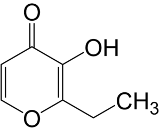The delicious flavors of food are actually produced by chemicals whose names can sound scary - but these chemicals are entirely natural.
By discovering the chemicals responsible for specific flavors, food scientists can produce foods with precisely controlled flavors.

Example List of
Chemicals that Flavor Foods
| Substance | Formula | Comments |
|---|---|---|
| Diacetyl | C4H6O2 |
Intensely buttery flavor; a fermentation product found in alcoholic drinks. IUPAC name: Butane-2,3-dione |
| Ethyl decadienoate | C12H20O2 |
Pear flavor and odor; also used in perfume products; found naturally in apples, grapes, pears, quince, and beer. IUPAC name: Ethyl (2E,4Z)-2,4-decadienoate |
| Ethyl maltol | C7H8O3  |
Caramelized sugar, cooked fruit, and cotton candy flavors; this is a synthetic chemical. IUPAC name: 2-Ethyl-3-hydroxy-4-pyranone |
| Ethyl propionate | C5H10O2 |
Fruity flavor, pineapple odor; traces found in strawberries and kiwis. Produced synthetically. IUPAC name: Ethyl propanoate |
| Ethylvanillin | C9H10O3  |
Strong vanilla flavor used in chocolate; it was one of the first (late 19th century) synthetic flavors added to foods. IUPAC name: 3-ethoxy-4-hydroxybenzaldehyde |
| Eucalyptol | C10H18O 

|
Eucalyptus - minty smell, spicy, cooling taste, added to mouthwashes and cough medicine (it is a cough suppressant). Produced from eucalyptus leaves. IUPAC name: 1,3,3-Trimethyl-2-oxabicyclo[2,2,2]octane |
| Isoamyl acetate | C7H14O2  |
Banana and pear flavors; found naturally in bananas, peppermint leaves, and is a fermentation product in beer. Produced synthetically for the food industry. IUPAC name: 3-Methylbutyl acetate |
| 2,6-Lutidine | C7H9N  |
Nut, bread, coffee aromas when used at low concentrations; found naturally in bread, tea, coffee, cooked beef and pork, cheeses, and beer. Produced synthetically for the food industry. IUPAC name: 2,6-Dimethylpyridine |
| Limonene | C10H16  |
Orange and citrus flavors; found naturally in citrus fruit rinds, from which it is extracted for the food industry. IUPAC name: 1-Methyl-4-(1-methylethenyl)-cyclohexene |
| Manzanate | C8H16O2 |
Apple with cider and pineapple hints; produced synthetically. IUPAC name: Ethyl 2-methylpentanoate |
| Menthone | C10H18O |
Peppermint odor; small amounts are found naturally in essential oils such as peppermint, and pennyroyal. Produced synthetically for the food industry. IUPAC name:(2S,5R)-2-Isopropyl-5-methylcyclohexanone |
| Methyl anthranilate | C8H9NO2 |
Grape flavor in Kool-Aid, candy, and chewing gum; found naturally in a number of sources including grapes, oranges, lemons, strawberries, and bergamont. Produced synthetically for the food and perfume industries. IUPAC name: Methyl 2-aminobenzoate |
